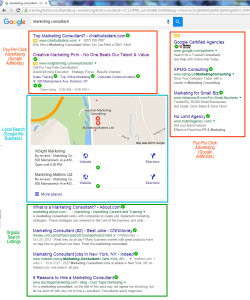Insight Marketing Blog
Spring is the Time to Clean Up Your Marketing – 6 Tips to Re-Engage Your Prospects

Spring is the time to refresh and renew – even your small business marketing!
With warmer temperatures and longer daylight hours on the way, spring is a time to refresh and renew. This applies equally to home projects, wardrobe changes and re-assessing your small business marketing. It’s easy to just let things lie or “hibernate” during the winter months with a functional website and a few social media posts. But come spring, it’s time to take a fresh look at how your marketing is really functioning. Is your website optimized for ever-growing mobile traffic? Are you consistently engaging your followers on social media? Are you driving traffic to your website? If not, you are turning away potential customers. Follow our 6 tips to re-engage, refresh and renew your prospects:
- Refresh your email template from a multi-column look to cleaner, single column design. If you created your email template a year or two ago, you were probably not concerned with it being mobile-friendly. Today, mobile email will account for up to 70% of email opens, depending on your target audience, product and email type. eMailmonday– “the Ultimate mobile email stats” (2015). Make sure your emails are optimized to be viewed on a mobile device by choosing a single-column template and make sure any buttons or links are “thumb-friendly,” meaning large enough and spaced out from other text so as to be easily clicked by a thumb.
- Just as your email needs to be mobile-friendly, your website needs to be built with a responsive design. Your site should be optimized so it looks just as good viewed on a large desktop screen as on a tiny Apple Watch. Responsive design is the new norm in web design so now is the time to move to a responsive web platform. According to Google, “more Google searches take place on mobile devices than on computers in 10 countries including the US and Japan.” (Read more here.) So get yourself a responsive, mobile friendly website or you’ll end up sending all your mobile prospect to your competitors.
- Does your Facebook page have cobwebs? Time to engage your customers. Make sure you have a strategy in place to post regular updates on your social media pages. In this digital age, prospects expect to see recent and relevant activity on social media and are quick to unfollow those pages that are not kept up-to-date.
- Declutter and refresh your website. Do you have outdated content or non-functional links on your website? Those could be costing you business. Take the time to “clean house” and make sure your links and contact information are up-to-date. Delete older content and refresh with current news, updates and photos. If you are in e-commerce, it’s a good time to take inventory and delete slow or non-selling products. What a great excuse for a “Spring Cleaning” sale!
- Time to refresh your logo? If your logo looks like it was created in the Dark Ages before Photoshop, it could probably stand a refresh. Even the most well-known brands tweak their logos every once in a while to convey a new modern feel. Even if you don’t have a huge budget, there are many affordable design services available today to help.
- Analyze your metrics and re-assess your strategies. It is essential to use website monitoring tools, such as Google Analytics, to know where your traffic is coming from. If your organic traffic is slowing down, you may want to revisit your SEO strategies. Adding new content to your website (see #4) is imperative to keep you relevant and ranking high in organic search results. Now may also be a good time to invest in some paid search or digital advertising to boost traffic to your site and increase your pool of potential new customers.
Paid Search vs. Organic Search or What am I clicking on when I run a Google search?
What happens when you type a search term into Google? Normally you’ll get a page full of results. Some of these will be matching pages from across the Internet. Some of these will be matching content from news sources or image links. More than likely, you will see ads that appear above or to the right of the main search results. These paid ads are known as Paid Search or PPC (pay-per-click) or Google Adwords and they are clearly differentiated from the organic search results by the word “ad” or “ads.”
1. What is PPC Marketing and why does my business need to use it?
PPC (pay-per-click) marketing is a form of online advertising in which advertisers pay when users click on their ads. These ads appear at the top and/or right side of internet searches so they are usually the first listings that users view and/or click on. In order to have your website ranked high up on Google organically can take a lot of work and time invested in your website. If you don’t have that kind of time or are not a web expert, than perhaps your best bet is a PPC campaign.
2. What is Google My Business and how do I make sure my business is listed?
Some search results may look like business listings with results plotted on a Google map. These map-type results are called Google Places or Google My Business pages.
Google has created a search algorithm which provides an easier way for local businesses to rank at the top of Google in searches within a specified geographical location. In many instances, Google My Business local listings will appear above organic search results.
It is more important than ever that your Google+ profile and page are optimized with complete and detailed business information to extend your likelihood of coming up in local searches. And the best part is there is no cost to you.
3. What is Organic Search or SEO?
Organic search refers to the natural search engine results that appear for any given search. The organic search results will appear just under the PPC ad and Google My Business results. You want to make sure your web content is optimized to appear in organic search engine results, so it will be easier for users to find you when searching valuable information. This optimization of keywords in your website does not cost you any money and is an important component of making your business more “searchable.”
4. So . . . What is the best search strategy for my business?
The answers will vary depending on what your immediate and long-term marketing goals are and how much you are willing to invest to achieve them. You will most likely want to use a combination of paid search and SEO. You should make sure your content is optimized for both, as this will allow you the flexibility to do both and have them complement each other. Your digital strategy will change and morph over time. As you grow your online brand awareness, you will necessarily shift your focus from just driving traffic to your site to more sales-driven conversion tactics.
Continue reading →Where are Greatest Marketing Opportunities for 2016?

Here is our road map to the top marketing trends for 2016
The start of a new year is a smart time to re-evaluate your marketing strategy, looking back on what proved successful, but also forward to what new trends look promising. Some marketing trends play themselves out in a matter of months, while others stick around for years. Either way, you cannot afford to stick your head in the sand, like the proverbial ostrich, while your competition moves ahead. Trends are changing so quickly in the digital landscape that those who do not participate will find themselves sorely lagging behind.
Many of the trends we highlighted in last year’s blog post are still going strong: mobile marketing, social media, integrated marketing – so this year’s may look familiar. Visual marketing continues to be important as businesses fight for their share of fragmented attention spans. Mobile isn’t going anywhere (with a few new developments we’ll discuss), and businesses will keep producing useful content to provide more value to their customers.
Now let’s look at what’s new for 2016.
1. Optimize for mobile
With the continued proliferation of smartphones and tablets in the last few years, it’s no surprise mobile has now officially become the dominant channel through which people access the internet. Mobile digital media time (51%) has now overtaken desktop at 42% according to eMarketer. That means businesses that are not optimized for mobile viewing will be at a distinct disadvantage. This also will have an impact on . . .
2. Location-Based Marketing Continues to Innovate
Mobile devices are the gateway to instant and effective marketing messages. Every consumer with a mobile device in hand is a target for messaging that is triggered by beacon technology. Retail and other “brick-and-mortar” businesses that have these beacons in place can detect when a customer is in close proximity, can then push timely, targeted messages to that customer. It’s a little “Big Brother is watching” and customers may be initially turned off by this privacy issue, but as this mode of marketing becomes more prevalent and accepted by consumers, it offers businesses with physical locations some tremendous marketing advantages.
3. Context Behind the Content
Google is getting finicky about recognizing good content. It is not just about the keywords anymore – the context behind the words and the value to the consumer is more important. Well written web content will become a major driver in 2016.
4. Social Media Drives Search
Social media channels are now being used to drive search to a large degree. Google has started indexing social media content so it is more important than ever to make sure your business maintains an active profile across all channels. Today’s consumer also uses social media to conduct research within the platforms themselves, sometimes even bypassing Google altogether.
5. Mobile Apps Keep Evolving
Mobile apps are still another mobile-friendly addition to increase your online presence. Google already includes content from apps in its search results and today’s consumer continues to download and access apps on a daily basis. More and more businesses are seeing the value of creating customized apps for their client base, to generate customer loyalty and making transactions easier. Mobile app store revenues worldwide are projected to grow to $76.5 billion in 2017 according to Statista. This data points to a move from the mobile web to mobile apps, especially for ecommerce.
6. Pop Ups Drive Conversion
New data shows that pop ups are an effective tool for driving email sign-ups with an enticing call to action. When used in the wrong context or for a hard sell, they can be annoying and intrusive. But when properly executed, pop-ups can work very well and furthermore can’t hurt. The more opportunities for email capture on your site, the better. We suggest you do your own testing and find out how it works for you.
7. User-Generated Content (UGC) Will Surpass Branded Content
Using content created by customers of your brand adds a more native feel to your marketing. Many consumers, especially the Millennial generation, look for user-generated content to help them make purchasing decisions. According to bazaarvoice, over half (51%) of Americans trust UGC more than other information on a company website (16%) or news articles about the company (14%) when looking for brand information. Make sure to put consumer opinions and images front and center on your website and social media channels.
Conclusion
In general, advancements in technology will bring marketers closer than ever to the consumer in 2016. The user experience will become ever more important in how they receive messaging and interact with brands. The technologies that make this possible will take center stage, helping marketers tell more cohesive brand stories (and at the same time more personalized), everywhere their customers are. And thanks to today’s skeptical, connected consumer, those stories will have to be rooted in transparency and authenticity – your customers will see through anything else.
Continue reading →